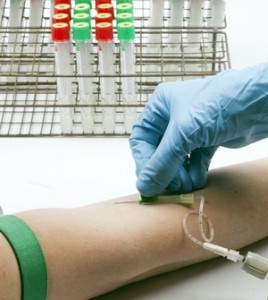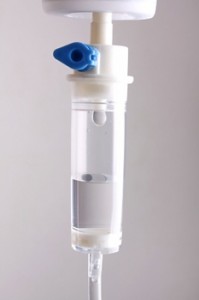
 Individuals who develop late stage Lyme disease may have very specific symptoms related to classical Lyme arthritis (hot, swollen, fluid-filled joints). These patients are relatively easy to diagnose, as greater than 95% have positive traditional testing (this is, a positive ELISA and Western Blot).” Many individuals, however, may develop a more insidious course of nonspecific and debilitating symptoms such as headaches, fatigue, waxing and waning joint and muscle pains, sharp, shooting pains, memory problems, and psychiatric problems (Physicians would label this as “change in mood and affect”) such as depression, to name a few.
Individuals who develop late stage Lyme disease may have very specific symptoms related to classical Lyme arthritis (hot, swollen, fluid-filled joints). These patients are relatively easy to diagnose, as greater than 95% have positive traditional testing (this is, a positive ELISA and Western Blot).” Many individuals, however, may develop a more insidious course of nonspecific and debilitating symptoms such as headaches, fatigue, waxing and waning joint and muscle pains, sharp, shooting pains, memory problems, and psychiatric problems (Physicians would label this as “change in mood and affect”) such as depression, to name a few.
In fact, late Lyme disease can mimic many other diseases. Individuals with these more nonspecific complaints who are truly infected with the Lyme disease bacterium have a more dismal track record with lab testing using the traditional ELISA and Western Blot. As few as 30% of these patients may be confirmed using these tests.
Since the major issue with late stage Lyme disease is infection of the brain, the only effective therapy consists of antibiotics that can only be administered intravenously. This increases the patient’s risk for adverse reactions related to the IV catheter and the medications utilized. Obviously if we can’t clearly prove that an individual’s symptoms are due to infection with Lyme disease, treatment of non-infected individuals can only lead to unnecessary complications, and not help the patient get well. It can even delay further evaluation that may lead to the correct diagnosis.
 Luckily, there are newer tests available for the diagnosis of Lyme disease that can accurately confirm infection with Lyme disease; the Lyme C6 peptide ELISA, and the Lyme PCR (a genetic based test that actually, directly finds the bacterium in an individual’s specimen.)
Luckily, there are newer tests available for the diagnosis of Lyme disease that can accurately confirm infection with Lyme disease; the Lyme C6 peptide ELISA, and the Lyme PCR (a genetic based test that actually, directly finds the bacterium in an individual’s specimen.)
New Tests for Late Stage Lyme Disease
In the 1990s, the Lyme PCR test became commercially available. When positive, it actually confirms that the Lyme disease bacterium is in the specimen. It is truly an amazing test that has no false positives.
Unfortunately the Lyme disease bacterium is present in an individual’s blood, urine, or even spinal fluid transiently, infrequently, and in very small quantities. A single negative Lyme PCR test doesn’t mean that the individual does not have Lyme disease, and retesting is usually indicated.
The Lyme C6 Peptide ELISA is very different than the earlier Lyme ELISA test. It was developed at Tulane University and available since the year 2000. It can confirm exposure in more than 60% of patients. The chance of a false positive result is under 1%. In contrast to the earlier developed traditional testing with the Lyme ELISA and Western Blot, within six months after successful cure of Lyme disease, the Lyme C6 Peptide ELISA has reverted to negative. If it remains positive there is a high level of suspicion that the individual may still be infected.
While these new tests, when positive, can confirm that an individual is infected with Lyme disease, there is still no test clinically available that, when negative, proves than individual does not have Lyme disease. The hunt for better tests goes on.
Late State Lyme Disease
These issues have led to huge controversy in the medical community about the spectrum of symptoms in Lyme disease, who has Lyme disease, and the treatment of Lyme disease. This has been due to a reliance on the Lyme ELISA and Western Blot by the medical community to confirm Lyme disease. Clinical studies in the peer-reviewed medical literature do not support this reliance. The interpretive criteria used in these tests help prevent a false positive result, but at the expense of many false negative results. Thus, to use an expression, it has a great potential to “throw out the baby with the bath water.”
If an individual lives in an area where Lyme disease is known to exist, has known, or significant risk of exposure to deer ticks, has unexplained and progressive disease features, and a negative ELISA and/or Western Blot for Lyme disease, should seek further evaluation for Lyme disease.
Symptoms of Late Stage/Chronic Lyme Disease
 Symptoms of late stage Lyme disease begin to occur somewhere between three months to one year after the initial infection. Invariably by this time, the Lyme disease organism penetrates into the brain. Once this occurs, oral antibiotics cannot be used to cure the Lyme disease infection. This is because the brain has a protective barrier (the blood-brain barrier) that prevents the passage of antibiotics into the brain tissue.
Symptoms of late stage Lyme disease begin to occur somewhere between three months to one year after the initial infection. Invariably by this time, the Lyme disease organism penetrates into the brain. Once this occurs, oral antibiotics cannot be used to cure the Lyme disease infection. This is because the brain has a protective barrier (the blood-brain barrier) that prevents the passage of antibiotics into the brain tissue.
The Blood-Brain Barrier
The blood-brain barrier is an important defense against many chemicals that may be toxic to the brain. Unfortunately, when the brain is infected, it is a deterrent to treatment. The only antibiotics that have been proven to be effective in treating late stage Lyme disease can only be administered intravenously. These are expensive and can be associated with an increased risk of complications from therapy.
In our opinion, the benefits outweigh the risks in those individuals who are adequately proven to be actively infected with Lyme disease. For many this may be a daunting task.
There is a storm of controversy over the duration of treatment for late stage Lyme disease. Some experts have recommended as little as two weeks of daily intravenous antibiotic therapy, while others recommend a year or more! This great disparity of opinion has occurred because of the lack of adequate studies to prove the best course. The truth for sure lies somewhere between these two extremes. The specifics of our approach to treatment of the late stage Lyme disease patient is beyond the scope of this website.
The Haverford Wellness Center under the direction of Domenic Braccia D.O.is dedicated to the accurate diagnosis and reasonable treatment of Lyme disease and other tick borne diseases. Dr. Braccia and the staff ot the Haverford Wellness Center are fully equipped and capable of managing all aspects of Lyme disease and the other tick borne diseases from prevention and management of early disease to the most complex diagnostic and therapeutic cases.


